
A sum even greater than its Parts. Not just any old Speedster but a four-cam Carrera: rarest and raciest of them all. The Speedster was the cheapest 356 – yet also the raciest, when fitted with the four-cam Carrera engine. John Simister discovers exactly why it’s now a £1-million car. Words John Simister. Photography Matthew Howell.
On the road in the raciest – and rarest – 356 of all: the sublime four-cam Carrera
A 356 Speedster. That’s a car in which to scoot along the California coast, or to drive in club races on the US’s eastern side: Sebring, Watkins Glen, Lime Rock. It’s about sun-drenched sportiness, not a care in the world as you flick between V8-powered leviathans in your nimble flat-four, be the battle on road or track.
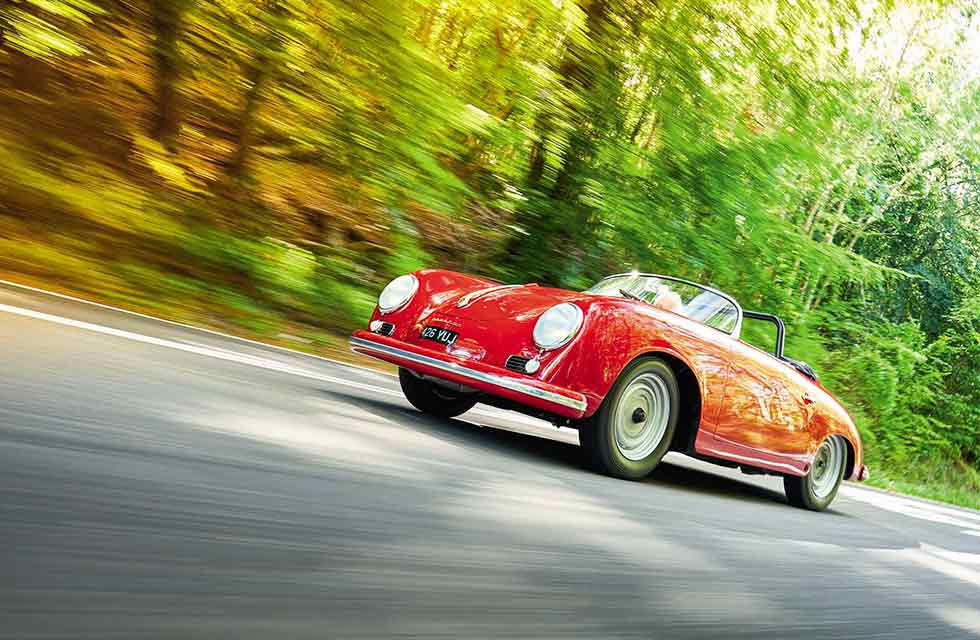
Max Hoffman was the man who first unleashed the carefree liberation that lay within the 356 idea. Porsche’s US importer saw a roofless, simplified 356, a roadster rather than a cabriolet, as the ideal riposte to Britain’s two-seater offerings, and a run of 15 of these distinctive-looking machines was built in 1952. Then John von Neumann, the West Coast distributor, proposed a purer idea inspired by the open, lightweight race car he had made out of an early Gmünd-built 356 coupé.
‘WITH THE SPEEDSTER, LESS IS MORE. THAT’S A THEME WE’VE OFTEN ENCOUNTERED WITH PORSCHES OVER THE YEARS’
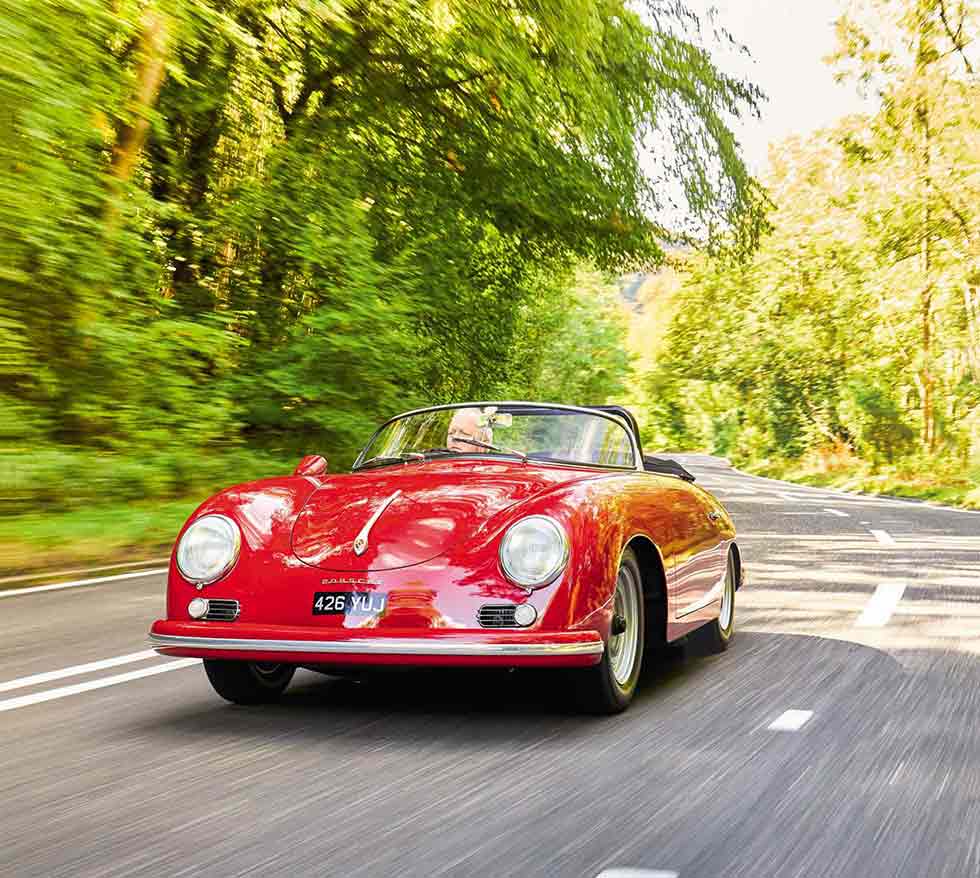
It would look more like a regular 356, in its bottom half at least, but the stripped-down, minimalist Speedster with its shallow windscreen would be the cheapest 356 and, for a given engine, the fastest. Give it the best engine, and it would be as speedy as the wildest dreams its name could generate.
So far, so very US-centred. But you will have noticed that the Ruby Red 356A Speedster on these pages is right-hand drive. Which country is hot, drives on the left and was likely to appreciate a Porsche Speedster in the 1950s? Australia? South Africa?
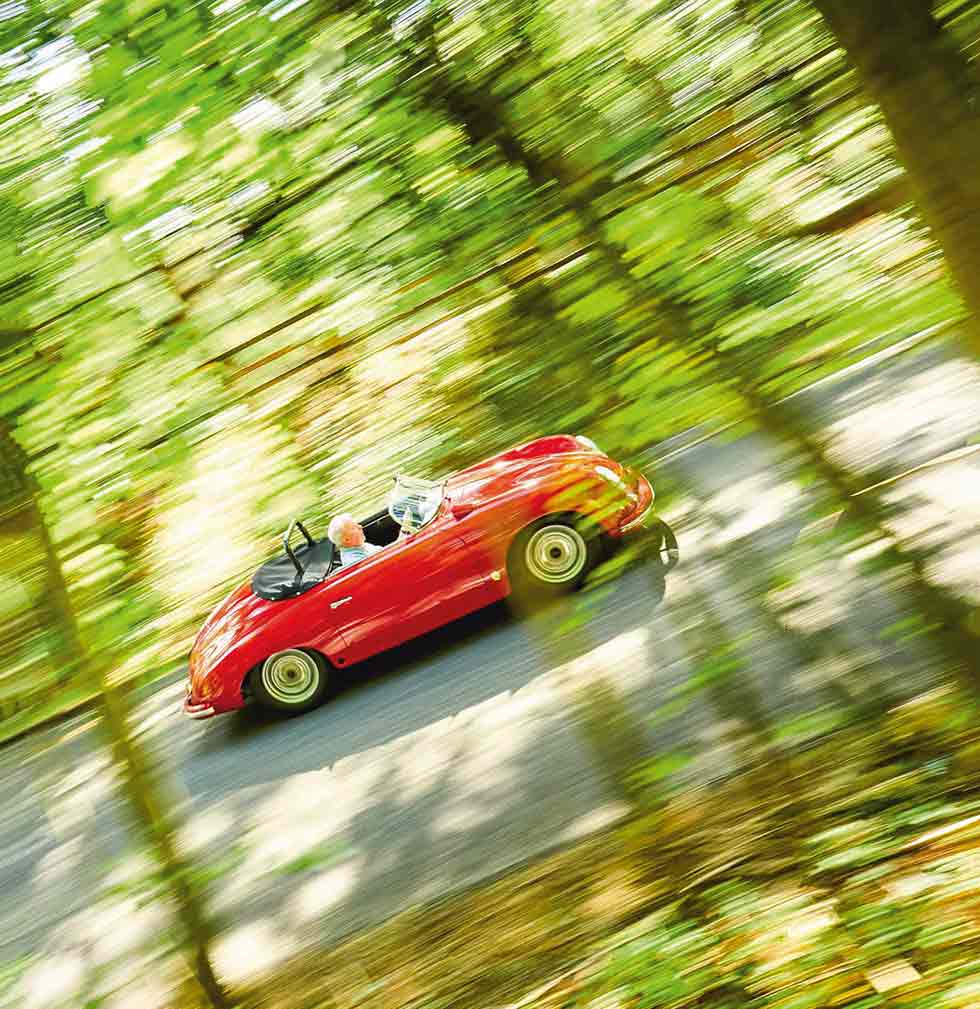
In the case of Speedsters with the ultimate four-camshaft Carrera engine, as here, Australia is the answer. Of the 4900 or so Speedsters made from 1954 to 1959, only 152 were Carrera four-cams. And of those, a mere three were right-hand drive. All of those were sold in Australia, and the first two, built in July 1956 and July 1957, are still there. So was the third car, built in September 1957, until 2011 when it arrived in the UK. That’s why you’re seeing it in the leafy Chiltern Hills of Buckinghamshire, not by Bondi Beach.
Fortunately, the sun is shining. And as I make myself comfortable in the black bucket seat, I can’t help wondering what has happened to our world of classic cars. This little sports car, with a 1.5-litre engine rated at 100bhp, is valued at £1 million. I’ll give you a moment or two and let that sink in.
But no now-classic Porsche was ever created as an investment opportunity, not even a 911 2.7 RS Carrera. Their designers and engineers would have been horrified at the prospect. So, while taking good care of my mount for the day, I can’t let that at once risible yet entirely credible value colour my relationship with it. If I let that happen, the Speedster’s purpose is lost.
‘PEAK POWER DOESN’T OFFICIALLY ARRIVE UNTIL 6200RPM – YES, IN THE RED ZONE. NO WONDER PEOPLE USED TO BLOW THEM UP’
That purpose is to meld man, machine and roadscape in an intimate thrill of windblown pleasure, freed from the chattels of formality, luxury and excess baggage. Given this car’s GT-specification 80-litre petrol tank under the rounded bonnet, there’s little room for the last of these anyway. The seat is low, the curved top of the windscreen similarly so; no other 356 in which I’ve sat has felt nearly as play-ready as this.
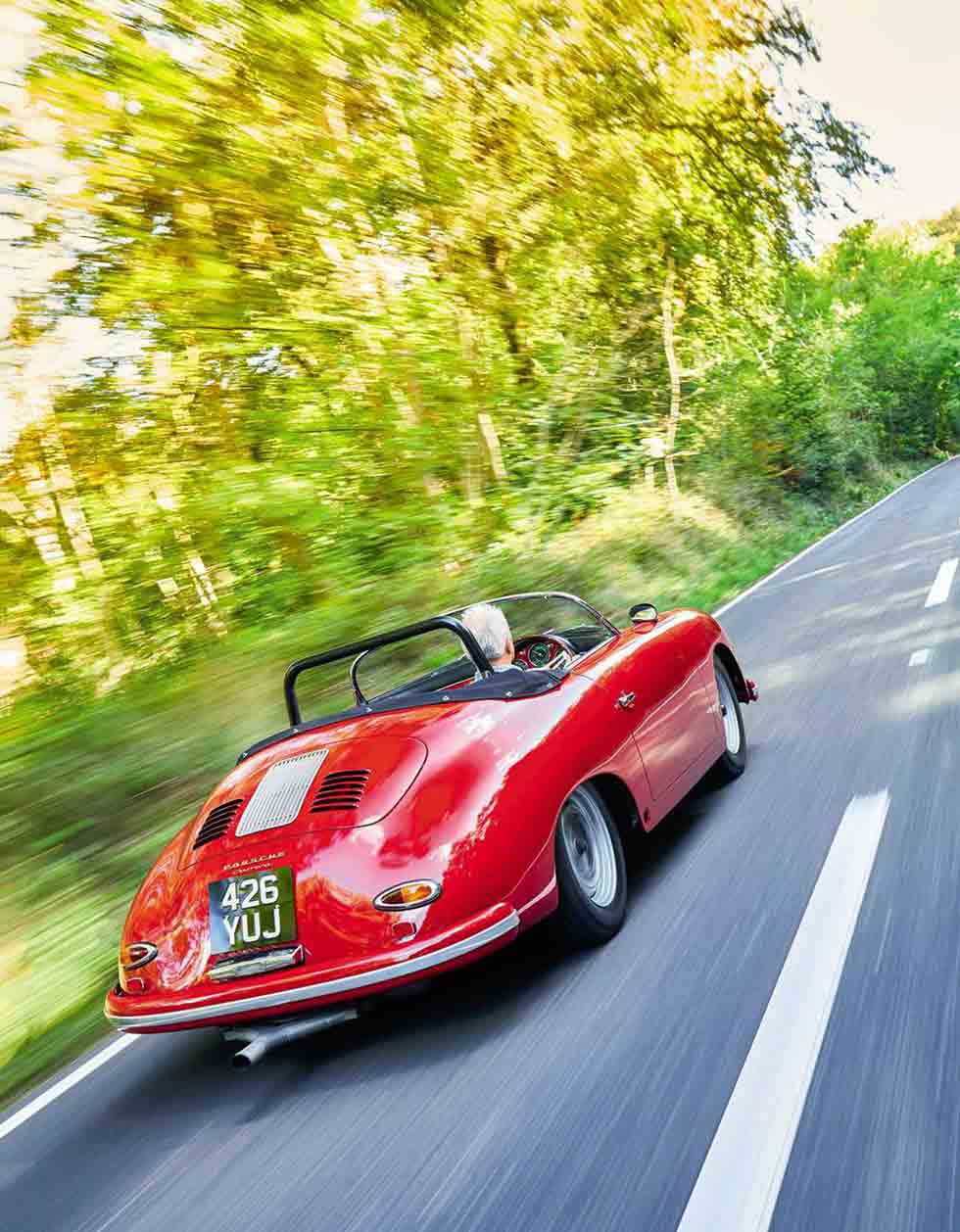
The engine chunters over on the starter and thrums into life. There’s no escaping the humble origins of its metallic flat-four beat. Here, though, it’s a bit deeper, harder, the single fat Sebring tailpipe, emerging dead centre, blaring with rapid-fire aural intermittency and the odd lift-off gunshot. ‘It doesn’t like ambling,’ says custodian Mick Pacey. ‘You need to keep the revs up and keep it moving, so it doesn’t foul the plugs.’
‘NO OTHER 356 IN WHICH I’VE SAT HAS FELT NEARLY AS PLAY-READY AS THIS’
That’s the mystique that goes with the famous four-camshaft flat-four, especially in this primordial form with a roller-bearing crankshaft. (The later 1.6- and 2.0-litre versions returned to normal plain bearings and conventional, albeit still dry-sump, lubrication.)
Engineer Ernst Fuhrmann’s Carrera motor is reverentially described by those in the know as highly strung, delicate, temperamental even, and setting up the right-angle gear drives to its four overhead camshafts requires saintly patience. Did it have to be thus? Don’t ask awkward questions; just enjoy it for what it is. What I’m expecting, then, is an engine as flat as a pancake at low revs but which erupts gloriously to life as the revcounter needle enters the green-shaded zone at 4000rpm, and crackles on to the red zone’s boundary at 6000rpm, beyond which I dare not venture. There’s a hefty 40mm carburettor barrel for each cylinder, courtesy of a pair of downdraught 40 PII-4s from versatile Franco-Anglo-Italo- German manufacturer Solex, so gas speeds at low revs will be low and combustion therefore surely sub-optimal.
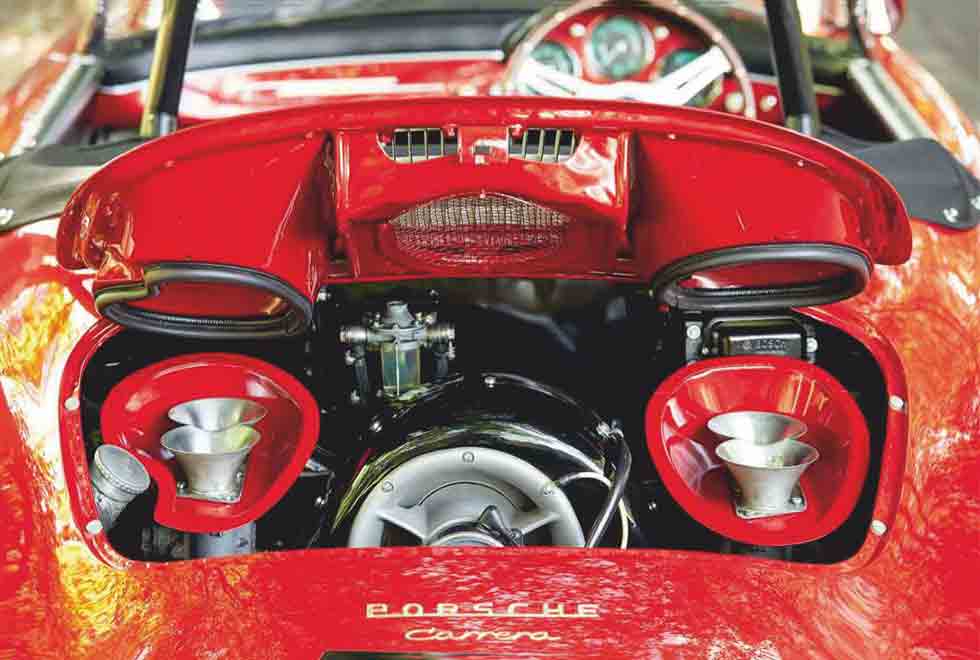
But they are lovely carburettors. Each bears a beautiful pair of overlapping trumpets, which are sealed in their own plenum chambers when the engine lid is shut. In this Carrera GT-specific system, air is sucked in through extra lateral louvres in the lid. It’s not filtered, so don’t expect the piston rings to last long given the dust generated by the rear wheels, which will surely be sucked up, over and into the direction of the intakes.
There should be dyspepsia followed by drama, but actually it doesn’t happen. As long as I don’t feed in too much accelerator too soon, the Speedster’s beating heart pulls happily and without snatch from under 2000rpm. At 3000rpm it can take full throttle, at 4000rpm it is definitely on a second wind but not explosively so. By 6000rpm it’s had enough, even though peak power doesn’t officially arrive until 6200rpm – yes, in the red zone. No wonder people, searching for the ultimate energy, used to blow them up.
Laurence Meredith’s 356 bible, Original Porsche 356, suggests a 110-115mph top speed for a 1.5-litre Speedster and an 8.7-second 0-60mph time. I’m not about to push this one to such extremes, but still I’m having plenty of fun as I prod the long, springy gearlever through its approximate gate in search of the shift of least resistance.

This is achieved, for an upshift, by either an inter-gear pause or, faster, an upward doubled-clutch because the synchromesh isn’t strong. Similarly, a double clutch-prod either side of an in-neutral throttle-blip is best for the downshifts if you want to demonstrate the right degree of mechanical sympathy. It’s entertaining, too, and goes with the Speedster’s hands-on, suck-you-in character.
This car’s suspension hasn’t been lowered or otherwise tweaked, so it steers, corners and rides as it should on regular rural roads. The steering isn’t the last word in precision but it’s quick, accurate and informative, so the Speedster is as easy to place as its diminutive dimensions suggest it should be. It grips keenly, helped by GT-spec wheels slightly wider than the Rudge knock-ons this car came with originally, and during a day’s spirited cruising through the Chilterns and beyond I never once feel any of the tail-end precariousness typical of an overworked swing-axle.
The Speedster’s low centre of gravity must help here. So must the suspension’s firm control of roll and wallow, impressively achieved without any underlying harshness or choppy encounters with the bumpstops. Whatever the surface, you just point, squirt, hold on and enjoy. And press the brake pedal very hard when you want to stop; even by the more modest standards of an all-drum system, these brakes are light on bite.
I’ve mentioned ‘GT’ a couple of times, although this is not the sort of car you’d think of as a grand tourer. An explanation is needed, which I’ll combine with a biography of this particular Speedster, chassis number 83727.
It was built to GS specification rather than the racier GT, which meant slightly less torque (but the same power), bumpers with overriders and an extra nudge bar, all-steel panels, covers for the rear torsion bars’ access holes in the body, and narrower brake drums. By the mid- 1960s, its fifth owner had repainted it in silver and replaced the original Carrera engine (number P90885, now lost) with a high-output VW motor, because doing that was cheaper than rebulding a four-cam. Complete with a melted piston, the four-cam engine itself went on display at a technical college, of which the owner’s father was the head of the automotive engineering department!
In 1982, seventh owner Trevor Keetly made the GS into a GT. This, of course, meant fitting a suitable Carrera engine, which he found in the USA. It bears the number P90897, merely 12 units away from the Speedster’s original motor, and was originally fitted to the fourth factory-built, GT-specification Speedster to be made.
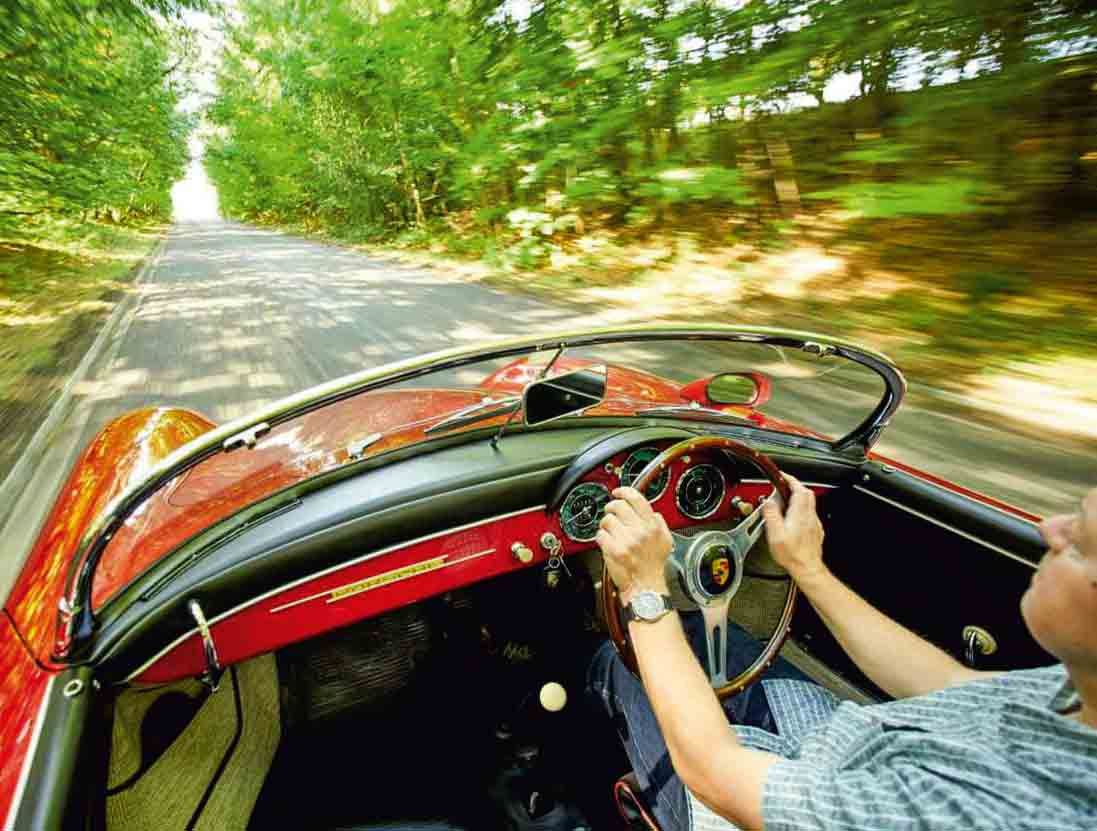
Then followed nearly all the other GT mods: plain bumpers, the big fuel tank, wider (5.5in) five-bolt wheels, the Sebring exhaust, a rollover bar, brakes 60mm broad instead of 50mm, and an aerodynamic, Spyder-style exterior mirror. But no GT engine lid just yet…
Also fitted was a popular period accessory that actually hailed from England: the Derrington steering wheel, a smart wood-rimmed item from Surrey tuning company VW Derrington. The engine and gearbox were rebuilt by specialists and life was good. And so it continued until the late 1990s, when fourth owner Warwick Miller reacquired the car he’d enjoyed so much three-and-a-half decades earlier.
He kept it until 2007, after which it had one more Australian owner until its emigration to the UK in 2011. The former GS was comfortable enough in its latter-day GT existence, but its owner decided it should be once again Ruby Red. What became a total restoration, including – finally! – the fitment of that aluminium extra-louvred GT engine lid, was carried out by British specialist Sportwagen, with further work by specialist Maxted-Page and Mick Pacey’s own company, Export56.
Such is the standard of the restoration that, in September last year, the Speedster won three awards at the Salon Privé Porsche 70th Anniversary concours: best open-top car, best engine and the Duke of Marlborough’s best car in the show.
‘Simple as a 356 might look,’ observes Mick, ‘it’s very hard to get the body right. You have to start by cutting off the whole front section from the A-pillar forward, and likewise the rear section.’ He then explains how it has to be built back up with any new metal as required, replicating the original and outwardly undetectable join across the front ‘clip’ a third of the way back over the wheelarch, while making sure all the panel gaps are exactly right because the bonnet’s fit has no adjustment.
‘It was a £140,000 restoration,’ he adds, ‘but any 356 will cost the same money to restore regardless of how valuable it is. Were they this good when they were new? People say they weren’t, but I was looking at an early Pre-A 356 from California that had covered just 40,000 miles and had never been apart. Its panel gaps were brilliant. They were actually good when they left the factory. It’s what happens afterwards that’s the problem.’

Speeding – not illegally, just enjoyably – back to the Speedster’s base, I’m clocking all the ways in which this car is so unlike any other 356 of my experience. It really boils down to the Speedster’s simplicity and Spartan-ness, achieved not through cheapness but through absence of stuff. The dashboard lacks a glovebox and an ashtray, and its instruments are hooded in a racy cowl. There are no side windows, unless you fit the slim sidescreens with their slit-like windows. The seats, leather and corduroy over a wooden frame, are pure race car. Simple, but so, so cool.
Yes, with the Speedster, less is more. That’s a theme we’ve often encountered with Porsches over the years, whether in a particular car’s appeal or in what you get for the price. It’s ironic, though, that the 356 body type that once cost the least is now worth the most. Especially when it houses that enigmatic Carrera engine.
Thanks To Export56, www.export56.com, which can provide further details on the car.
TECHNICAL DATA FILE SPECIFICATIONS 1957 Porsche 356A Carrera GT Speedster
Engine 1498cc rear-mounted air-cooled flat-four, roller-bearing crankshaft, DOHC per bank, dry sump, two Solex 40 PII-4 twin-choke carburettors
Max Power 100bhp @ 6200rpm
Max Torque 91lb ft @ 5200rpm
Transmission Four-speed manual transaxle, rear-wheel drive
Steering ZF worm and peg
Suspension
Front: parallel paired trailing links, torsion leaves, telescopic dampers, anti-roll bar.
Rear: swing axles, torsion bars, telescopic dampers.
Brakes Drums
Weight 885kg
Top speed 115mph
0-60mph 8.7sec






